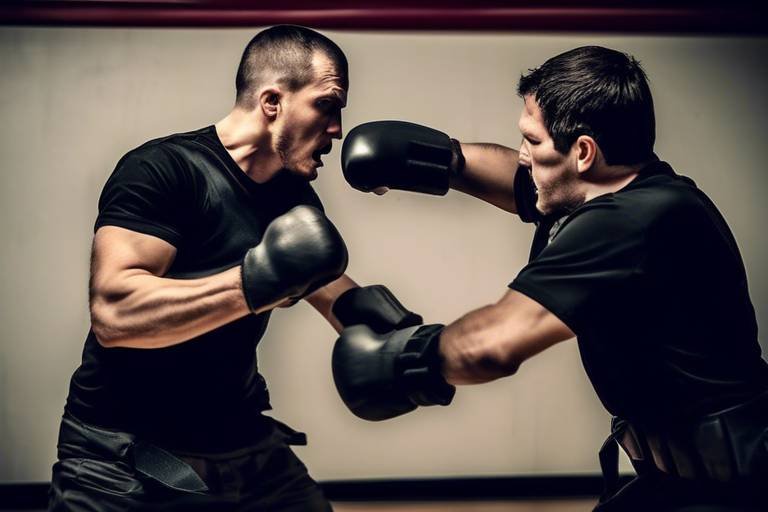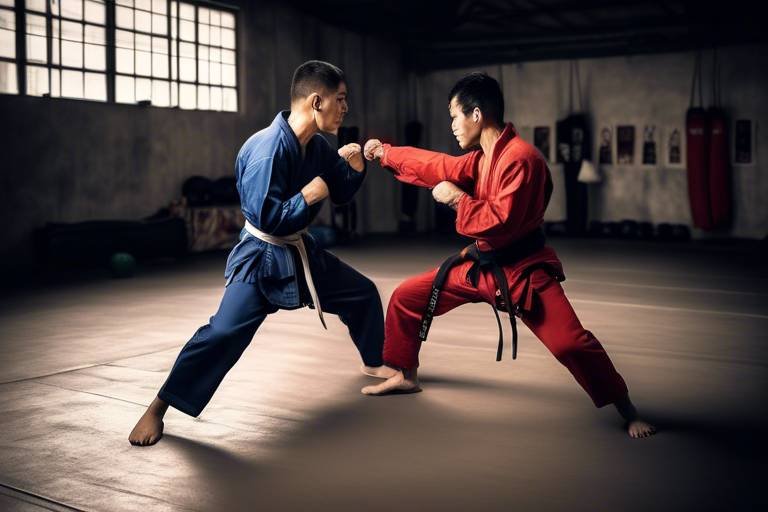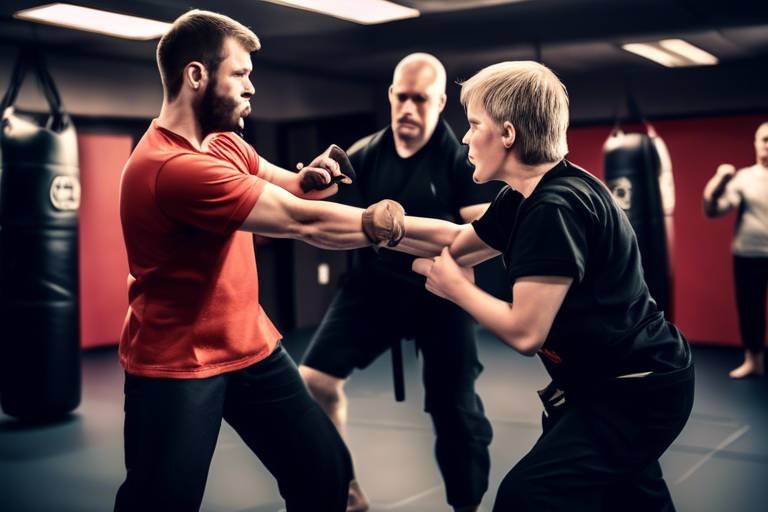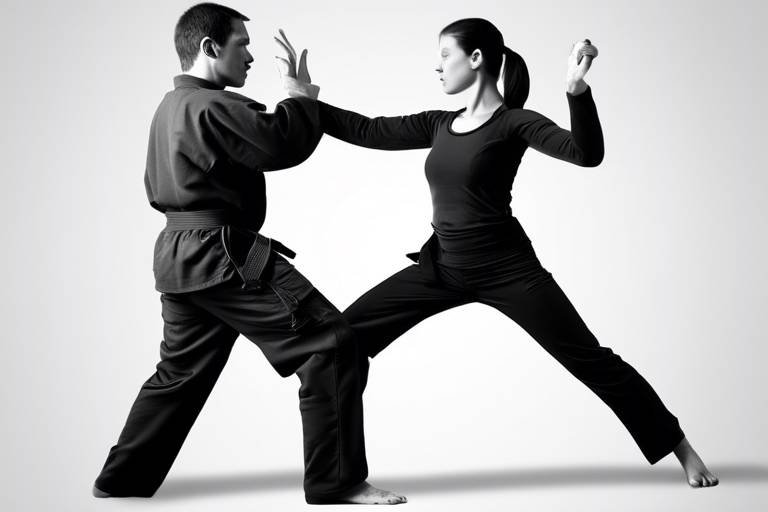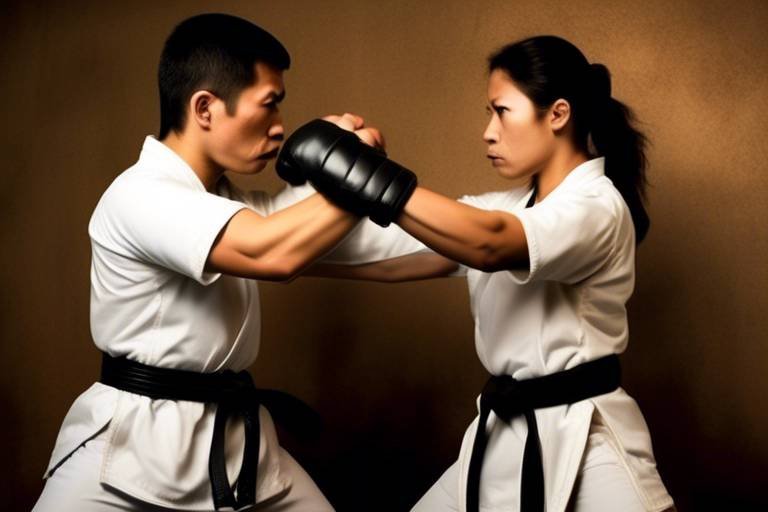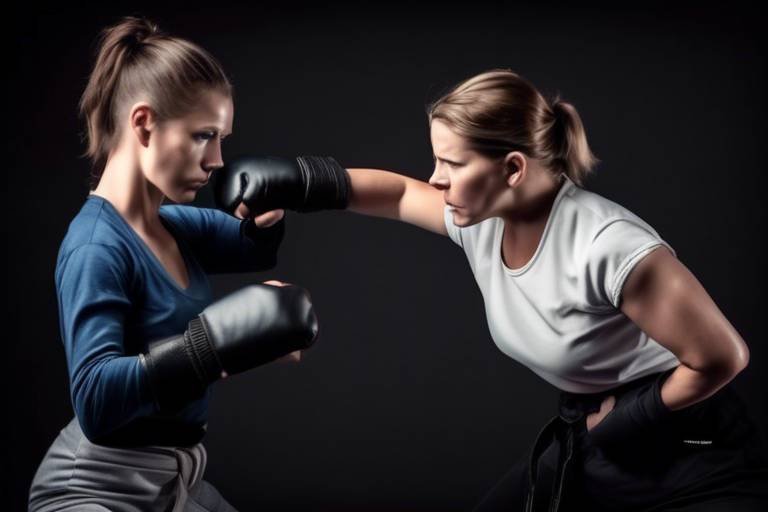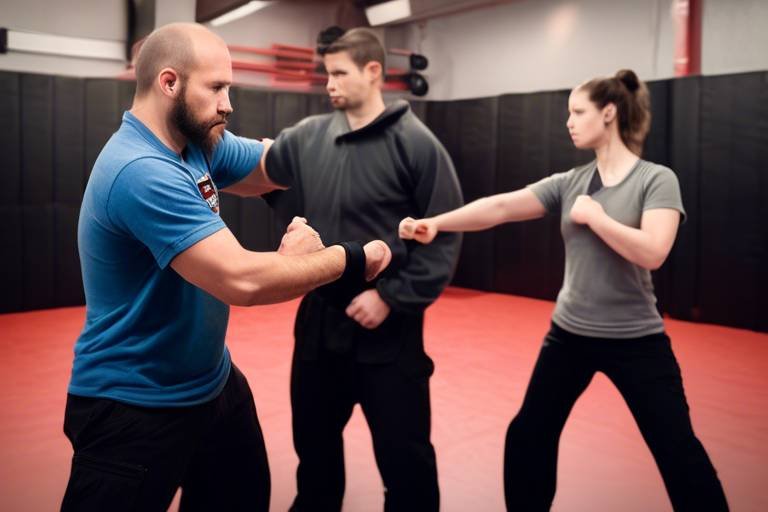Use of Everyday Objects as Weapons in Self-Defense Techniques
In a world where unexpected situations can arise at any moment, being prepared for self-defense is crucial. The thought of facing an attacker can be intimidating, but what if I told you that you don’t need to carry a weapon to protect yourself? Everyday objects around you can be transformed into effective self-defense tools. Imagine walking down the street, and instead of feeling vulnerable, you feel empowered, knowing that a simple item in your bag can help you fend off an attacker. This article dives into the creative and resourceful ways you can utilize common items for self-defense, ensuring you can protect yourself in dangerous situations.
Self-defense isn’t just about physical strength; it’s about being smart and resourceful. Think of it as a game of chess, where strategy plays a pivotal role. By understanding how to use everyday objects as weapons, you can turn the tables in a threatening situation. From your keys to your bag, the items you often overlook can become your best allies. Let’s explore how you can harness the power of these common objects to safeguard yourself.
Self-defense is a fundamental right that allows individuals to use reasonable force to protect themselves from harm. However, the legal and ethical aspects of self-defense can be complex. It’s essential to understand when and how to respond to an attack. For instance, did you know that the level of force you can use in self-defense varies by location? Laws differ across regions, and what may be acceptable in one area could be deemed excessive in another. That's why education about self-defense laws in your area is crucial.
Moreover, self-defense is not just about physical confrontation; it also involves awareness and avoidance strategies. Knowing how to read a situation and recognizing potential threats can often prevent an encounter before it escalates. It’s about being proactive, not reactive. So, before we dive into the practical uses of everyday objects, let’s take a moment to reflect on the importance of understanding self-defense principles.
Many ordinary items can serve as effective self-defense tools. The beauty of these objects lies in their accessibility; you don’t need to invest in expensive gear or weapons. Instead, you can look around your home, office, or even your pocket to find potential self-defense tools. Here are some common items that can be transformed into self-defense weapons:
- Keys: More than just a means to unlock doors.
- Umbrellas: A surprising yet effective barrier.
- Bags: Versatile tools for both offense and defense.
- Pens and Pencils: Everyday writing instruments with striking potential.
Let’s delve deeper into how these objects can be utilized effectively in self-defense scenarios.
When it comes to self-defense, your keys can be a powerful tool. They are not just for unlocking doors; when held correctly, they can be wielded as a striking instrument. Imagine gripping your keys tightly in your hand, with the key protruding between your fingers. This grip can enhance your striking power, allowing you to target vulnerable areas of an assailant's body, such as the eyes or throat. The key is to strike quickly and decisively, creating an opportunity for you to escape.
Proper grip techniques can significantly enhance the effectiveness of keys as a self-defense weapon. Hold your keys tightly, ensuring that the key you intend to use for striking is positioned for maximum impact. The ideal grip involves placing the key between your index and middle fingers, allowing for a swift jab or slash. This technique not only provides better control but also makes your strike more powerful, giving you a better chance to fend off an attacker.
Identifying target areas is crucial for effective self-defense. Striking vulnerable spots on an assailant can create opportunities for escape. Here are some key areas to aim for:
- Eyes: A quick jab can temporarily blind an attacker.
- Throat: A strike here can cause significant pain and disruption.
- Groin: A swift kick or jab can incapacitate an assailant.
By knowing where to strike, you can maximize the impact of your self-defense efforts, even with something as simple as your keys.
An umbrella can be a surprisingly effective self-defense tool. When wielded properly, it can be used to block incoming strikes, create distance, or even strike back at an attacker. Imagine using your umbrella to deflect an attack, then quickly transitioning to a strike. The key is to maintain control of the umbrella and use it to your advantage. In situations where you feel threatened, an umbrella can serve as both a shield and a weapon, providing you with multiple options for defense.
Improvisation is key in self-defense scenarios. Everyday items like bags, pens, and even clothing can be turned into effective weapons when needed. The ability to think on your feet and utilize what you have at hand can make all the difference in a critical moment. For instance, a bag can be swung to strike an attacker or used to shield yourself from blows. Similarly, pens and pencils can serve as jabbing tools, providing you with a means to defend yourself when necessary.
A bag can be a versatile tool in self-defense. Not only can it shield you from blows, but it can also be used offensively to strike an assailant. Consider holding your bag tightly and swinging it towards the attacker, using its weight to your advantage. This method can catch an assailant off guard, allowing you to create distance and escape.
Common writing instruments like pens and pencils can be transformed into self-defense tools with a little creativity. A pen can be used for jabbing or striking, targeting vulnerable areas such as the eyes or throat. The element of surprise is on your side; attackers often don’t expect a seemingly innocuous item to be used against them. By being aware of your surroundings and ready to act, you can turn everyday items into powerful self-defense weapons.
Q: Are everyday objects really effective for self-defense?
A: Yes, many everyday objects can be effective self-defense tools when used properly. Items like keys, umbrellas, and bags can provide you with the means to protect yourself in threatening situations.
Q: Is it legal to use everyday objects for self-defense?
A: The legality of using everyday objects for self-defense varies by location. It’s essential to understand the self-defense laws in your area to ensure you’re acting within your rights.
Q: How can I practice using these objects for self-defense?
A: Consider taking self-defense classes that focus on improvised weapons. Practicing with friends or family members can also help you build confidence in using everyday objects for protection.

Understanding Self-Defense
Self-defense is more than just a physical reaction; it’s a fundamental right that empowers individuals to protect themselves from harm. But what exactly does it mean to defend oneself? It’s about using reasonable force to ward off an aggressor when faced with imminent danger. This concept is rooted in both legal and ethical principles, which vary from one jurisdiction to another. Understanding these nuances is crucial, as it helps you navigate the often murky waters of self-defense laws.
Legally speaking, self-defense is justified when a person perceives a threat and responds in a manner that is proportionate to the danger they face. For instance, if someone is being physically attacked, they may use force to escape the situation. However, if that force is excessive—like using a weapon when the assailant is unarmed—it may not be legally justified. This is where the importance of understanding the law comes into play. Knowing when and how to respond can make the difference between being seen as a victim or a perpetrator.
Ethically, self-defense raises questions about morality and responsibility. It’s essential to consider not just your safety, but also the potential consequences of your actions on others. For example, using an everyday object as a weapon might be necessary in a life-threatening situation, but it’s vital to assess whether there are safer alternatives, such as de-escalation or escape. In many cases, the best self-defense strategy is to avoid confrontation altogether. Yet, if you find yourself in a situation where self-defense is unavoidable, knowing how to react appropriately can be lifesaving.
Moreover, self-defense isn’t just about physical techniques; it also encompasses mental preparedness. Being aware of your surroundings and recognizing potential threats can significantly enhance your ability to respond effectively. Consider the following key points when thinking about self-defense:
- Awareness: Stay alert to your environment and the people around you.
- Preparedness: Have a plan in mind for various scenarios.
- De-escalation: Whenever possible, seek to diffuse a situation before it escalates.
In summary, understanding self-defense involves a blend of legal knowledge, ethical considerations, and mental readiness. By equipping yourself with this knowledge, you empower not only yourself but also those around you to act wisely in the face of danger. Remember, the ultimate goal is to protect yourself while minimizing harm to others, and that requires a thoughtful approach to every situation.

Common Everyday Objects
When it comes to self-defense, many people might think that only specialized tools or martial arts training can provide real protection. However, the truth is that many ordinary items found around us can be transformed into effective self-defense tools. The beauty of using everyday objects lies in their accessibility; you don’t need to carry around a self-defense weapon when you have a plethora of options at your fingertips. Imagine being in a precarious situation and realizing that the very items you use daily can help turn the tide in your favor. This realization not only empowers you but also encourages a mindset of creativity and resourcefulness.
Consider the potential of items like keys, umbrellas, bags, and even pens. Each of these objects, often overlooked, can serve a purpose far beyond their intended use. For instance, your house keys can be a striking tool, while an umbrella can act as a barrier or a weapon. The key is to understand how to utilize these objects effectively when the need arises. Not only does this knowledge prepare you for unexpected situations, but it also builds your confidence in handling potential threats.
Let's take a closer look at some of these everyday objects that can be repurposed for self-defense:
- Keys: They can be used to jab or scratch an assailant, targeting sensitive areas.
- Umbrellas: A sturdy umbrella can be used to block strikes or even deliver a powerful blow.
- Bags: A bag can shield you from an attack or be swung to distract an assailant.
- Pens and Pencils: These can be used for quick jabs, targeting vulnerable spots effectively.
By recognizing the potential of these objects, you can equip yourself with the knowledge to respond effectively in a threatening scenario. The key is to remain aware of your surroundings and think quickly. Remember, self-defense isn’t just about brute strength; it’s about using your environment to your advantage. So the next time you step out, take a moment to look around and consider how the items you see could be used in an emergency. This mindset could very well be the difference between safety and danger.

Keys
When you think of keys, the first thing that comes to mind is likely unlocking doors or starting your car. However, these everyday objects can also serve as effective self-defense tools. Imagine being in a situation where you feel threatened; having your keys at hand can provide you with a surprising advantage. Instead of merely viewing them as functional items, consider their potential as a means of protection. With a little creativity and the right technique, your keys can become a powerful ally in a time of need.
Using keys for self-defense revolves around two main aspects: grip and targeting. The way you hold your keys can significantly impact their effectiveness as a striking tool. It's essential to grip them firmly, allowing for maximum force when striking an assailant. Hold the keys between your fingers, with the jagged edges protruding outward. This grip not only gives you better control but also allows you to deliver a swift jab to vulnerable areas of an attacker's body.
Now, let's talk about those vulnerable spots. Knowing where to strike can mean the difference between escape and harm. Aim for soft targets such as:
- The eyes – A quick jab can temporarily blind an attacker, giving you a chance to flee.
- The throat – A well-placed strike can disrupt breathing and create an opportunity to escape.
- The groin – A strike here can incapacitate an assailant, allowing you to escape quickly.
In the heat of the moment, it’s crucial to remain calm and focused. Your keys can be a powerful tool if used correctly. Practice holding them in a way that feels natural and familiarize yourself with the target areas. Remember, the goal is not to engage in a prolonged confrontation but to create an opportunity for escape. By being aware of your surroundings and prepared to use what you have at hand, you empower yourself to respond effectively in dangerous situations.
In summary, keys are not just mundane objects; they can be transformed into effective self-defense weapons with the right mindset and technique. So next time you reach for your keys, think beyond their usual purpose. They could be your first line of defense in an unexpected situation.

Grip Techniques
When it comes to using keys as a self-defense tool, the grip technique you employ can make all the difference in the world. Imagine holding a small object that has the potential to protect you; it’s not just about swinging it wildly but rather about how you hold it. The ideal grip should feel secure and allow for quick, decisive movements. You want to ensure that in a moment of panic, your keys don’t slip out of your hand.
To achieve an effective grip, place your fingers around the key, positioning it between your index and middle finger. This way, the key’s teeth protrude, ready to strike. Think of it as holding a miniature sword; you want to be in command of your weapon. Your thumb should press firmly against the back of the key for added stability. By doing this, you’re not only securing the key but also providing yourself with the leverage needed to deliver a powerful jab.
In a high-stress situation, remember to keep your hand relaxed but firm. A tense grip can lead to a loss of control, which is the last thing you want when defending yourself. If you feel the need to strike, aim for vulnerable areas of your assailant's body, such as the eyes, throat, or groin. These target areas can create an opportunity for you to escape.
To summarize the key aspects of grip techniques, consider the following points:
- Secure Hold: Ensure your grip is firm to prevent slipping.
- Proper Positioning: Hold the key between your index and middle fingers for better control.
- Relaxed Tension: Keep your hand relaxed to maintain dexterity.
By mastering these grip techniques, you’ll be better prepared to use your keys effectively in a self-defense situation. The next time you walk alone at night, remember that your keys are more than just a means to unlock doors; they can be a lifeline in a dangerous moment.

Target Areas
When it comes to self-defense, knowing where to strike can make all the difference. Targeting vulnerable areas on an assailant not only increases your chances of escaping unharmed but also allows you to use minimal force effectively. Think of it like aiming for the bullseye in archery; precision can be more impactful than brute strength. Here are some key areas to focus on:
- Eyes: A strike to the eyes can temporarily blind an attacker, giving you precious seconds to escape.
- Nose: A quick jab to the nose can cause pain and disorientation, making it harder for the assailant to continue their advance.
- Throat: Targeting the throat can disrupt breathing and create an opportunity for you to flee.
- Solar Plexus: A well-placed strike here can knock the wind out of someone, leaving them gasping and vulnerable.
- Knees: A swift kick to the knees can destabilize an attacker, potentially taking them down and allowing you to escape.
By focusing on these vulnerable areas, you can maximize the effectiveness of your self-defense techniques. Remember, the goal is to create an opening for escape, not to engage in a prolonged confrontation. It’s all about being resourceful and quick on your feet, just like a chess player thinking several moves ahead. In a moment of danger, having this knowledge can transform an ordinary object, like your keys, into a powerful tool for self-protection.
Moreover, practicing these strikes can enhance your confidence and readiness. Think of it as training for a sport; the more you practice, the more instinctive your reactions become. Whether it’s striking the nose or targeting the throat, each technique can be tailored to your comfort level and physical abilities. So, next time you reach for your keys, remember that they can be more than just a means to unlock doors; they can also serve as a lifeline in a critical situation.

Umbrellas
When you think of an umbrella, the first image that comes to mind is probably a rainy day or a sunny afternoon. However, this common object can serve a much more important purpose: self-defense. You might be surprised to learn that an umbrella can be transformed into a versatile defensive tool. In a threatening situation, it can act as a shield, a striking weapon, or even a means to create distance between you and an attacker. The key lies in understanding how to use it effectively.
To start, consider the structure of an umbrella. Its long handle can be used to jab or poke, while the canopy can be employed to block incoming strikes. Imagine the umbrella as a sword; its length allows you to keep an assailant at bay, giving you precious seconds to escape or call for help. By practicing specific techniques, you can harness the umbrella's potential and turn it into a formidable self-defense tool.
Here are some techniques for using an umbrella in self-defense:
- Blocking: The broad canopy can be used to deflect strikes. By raising the umbrella in front of you, you create a barrier that can absorb blows, giving you time to react.
- Jabbing: The pointed end of a closed umbrella can serve as an excellent jabbing tool. Aim for vulnerable areas such as the eyes, throat, or solar plexus, where a quick jab can create an opportunity to escape.
- Creating Distance: Use the umbrella to push against an attacker. The length of the handle allows you to maintain space, making it harder for them to reach you.
It's important to remember that the effectiveness of using an umbrella in self-defense comes down to your confidence and ability to remain calm under pressure. Like any self-defense technique, practice is essential. Consider enrolling in a self-defense class that incorporates everyday objects, or simply practice these techniques at home. The more familiar you become with using your umbrella in various scenarios, the more instinctive your responses will be in a real-life situation.
In conclusion, the next time you grab your umbrella before heading out, remember that it can be more than just a shield against the elements. With a little creativity and practice, this everyday object can empower you to take charge of your safety. So, whether it’s raining or shining, keep your umbrella in mind as a potential ally in self-defense!
Q1: Can using an umbrella for self-defense be considered legal?
A1: Yes, using an umbrella for self-defense is legal as long as you use reasonable force to protect yourself from harm. Always be aware of your local laws regarding self-defense.
Q2: What should I do if I feel threatened and don’t have an umbrella?
A2: Look for other everyday objects around you that can be used for self-defense, such as bags, keys, or even your phone. The key is to stay aware of your surroundings and be prepared to improvise.
Q3: How can I practice using an umbrella for self-defense?
A3: You can practice by enrolling in self-defense classes that focus on everyday objects, or you can practice techniques at home with a friend acting as a mock attacker. Regular practice will help you feel more confident.

Improvised Weapons
When it comes to self-defense, sometimes the most effective tools are those we carry with us every day. Improvisation is not just a skill; it’s a mindset that can mean the difference between safety and danger. In moments of crisis, your creativity can turn ordinary items into powerful self-defense weapons. Imagine a scenario where you find yourself cornered, and instead of panicking, you quickly assess your surroundings. You realize that your bag, pen, or even your clothing can be transformed into a means of protection. This section dives deep into how to make the most of what you have at your disposal.
One of the most versatile items you can use is your bag. Whether it's a backpack, purse, or tote, bags can serve multiple defensive purposes. For instance, you can use your bag to shield yourself from incoming strikes or to create distance between you and an attacker. When swung correctly, a bag can deliver a surprising amount of force, especially if it contains heavy items like a laptop or books. The key is to maintain control and focus on striking vulnerable areas of the assailant's body, such as the face or torso. Additionally, you can use the straps of your bag to entangle an attacker's limbs, providing you with the precious seconds needed to escape.
Another common item that can be easily overlooked is the pen or pencil. These everyday writing instruments can be transformed into effective self-defense tools. When held firmly, a pen can be used for jabbing or stabbing, targeting sensitive areas like the eyes or throat. The advantage of using a pen is its discreetness; it’s something you can carry without drawing attention. In a pinch, even a pencil can serve a similar purpose. Remember to grip it tightly and aim for those vulnerable spots to maximize your impact. It's all about being quick, decisive, and knowing where to strike.
Clothing can also be utilized in self-defense. For example, a loose jacket can be used to create a barrier between you and an attacker, while a belt can serve as a whip or a means to restrain an assailant. The fabric of your clothing can also be used to distract or blind an attacker momentarily, giving you the chance to escape. Think of your clothing as an extension of yourself; it’s not just for style but can also be a tool for survival.
In conclusion, the essence of self-defense lies in your ability to adapt and improvise. The next time you step out, take a moment to consider how the items around you can be utilized in an emergency. By thinking outside the box, you can turn the mundane into the extraordinary, ensuring that you’re always prepared to protect yourself.
- Can any item be used as a weapon in self-defense? Yes, virtually any item can be used creatively as a weapon if you know how to leverage its features effectively.
- Is it legal to use improvised weapons in self-defense? The legality of using improvised weapons varies by jurisdiction. It's important to understand local laws regarding self-defense.
- What should I prioritize when choosing an improvised weapon? Focus on accessibility, weight, and the ability to create distance or deliver force effectively.

Using a Bag
When it comes to self-defense, the most unassuming items can often become your best allies, and a bag is no exception. Whether it's a backpack, handbag, or tote, your bag can serve as a versatile tool in a dangerous situation. Imagine walking down the street and suddenly finding yourself in a threatening scenario. You might not have a self-defense weapon on hand, but your bag can be transformed into a shield or a striking implement with just a bit of creativity.
First off, let's talk about how you can use your bag defensively. If someone approaches you aggressively, holding your bag in front of you can create a physical barrier, buying you precious seconds to assess the situation or make a quick escape. By positioning your bag between you and the attacker, you can deflect blows and keep a safe distance. This is especially effective if your bag is sturdy or contains heavy items; the added weight can absorb some impact, making it harder for an assailant to reach you.
Now, if the situation escalates and you need to take a more offensive approach, your bag can become a striking weapon. Here’s how:
- Swinging: If you're wearing a crossbody bag, you can quickly swing it at your attacker. The momentum can add force, making it an effective strike.
- Jabbing: If your bag has a hard surface or contains heavy items, you can jab it into the assailant's body. Aim for vulnerable areas such as the stomach or chest.
- Throwing: In a pinch, throwing your bag at the attacker can serve as a distraction, giving you a moment to escape.
In addition to these techniques, it’s important to consider the contents of your bag. A bag filled with items like water bottles, books, or even a laptop can significantly increase its weight and impact. In a self-defense scenario, this means that not only is your bag a tool for protection, but it also has the potential to inflict damage if used correctly. The key is to remain calm and think on your feet; your bag is not just a carrier of your belongings but a potential lifeline in an emergency.
Ultimately, the versatility of a bag in self-defense situations cannot be overstated. Its ability to function as both a shield and a weapon provides you with multiple avenues for protection. So, the next time you grab your bag, remember that it holds more power than you might think. It’s not just a fashion accessory or a storage solution; it can be a crucial component of your personal safety strategy.
Q: Can any type of bag be used for self-defense?
A: Yes, almost any bag can be used for self-defense. The key is to assess its weight and sturdiness. A heavier bag can be more effective for striking, while a larger bag can provide better coverage as a shield.
Q: What should I keep in my bag for self-defense purposes?
A: Consider carrying items that can add weight or serve as improvised weapons, such as a water bottle, books, or even a flashlight. Just make sure they are easily accessible.
Q: Is it legal to use a bag for self-defense?
A: The legality of using a bag for self-defense varies by location. Generally, as long as you use reasonable force to protect yourself, it is permissible. Always check local laws for specific regulations.

Pens and Pencils
When you think about self-defense, the first thing that probably comes to mind is not a pen or a pencil. However, these everyday writing instruments can become surprisingly effective tools in a pinch. Imagine finding yourself in a tight spot, and all you have is your trusty pen. Instead of viewing it merely as a tool for writing, you can turn it into a means of protection. The beauty of these objects lies in their accessibility; they're items you carry with you daily, making them perfect for self-defense situations.
So, how exactly can you wield a pen or pencil for self-defense? First, let's talk about grip. To maximize your effectiveness, hold the pen firmly, similar to how you would grip a dagger. By doing this, you can use it to jab at an assailant's vulnerable areas, such as the eyes, throat, or even the groin. Striking these sensitive spots can create an opportunity for you to escape the situation. Think of it as using a small but mighty tool to fend off danger.
Now, you might be wondering, “What makes a pen or pencil so effective?” Here are a few reasons:
- Concealability: They can easily be hidden in your pocket or bag, making them an unobtrusive choice.
- Surprise Factor: An attacker likely won’t expect you to use a pen as a weapon, which gives you an advantage.
- Versatility: They can be used for jabbing, striking, or even as a distraction if you throw them.
It's important to remember that while pens and pencils can be effective, they should be used as a last resort. The goal of self-defense is to escape, not to engage in prolonged confrontation. In a situation where you feel threatened, aim to create enough distance between you and your attacker to make your getaway. Your pen or pencil is merely a tool to help you achieve that.
Additionally, consider the type of pen you have. A metal pen may provide more impact than a plastic one, so if you're looking for a self-defense tool, opt for something sturdy. The weight and structure of the pen can enhance the effectiveness of your strikes. Similarly, a pencil can be used for jabbing, but be cautious of breakage. A sturdy mechanical pencil can be a good choice as it offers a consistent point for striking.
In summary, while they may not be the first items that come to mind when preparing for self-defense, pens and pencils can be valuable tools in a potentially dangerous situation. By understanding how to use them effectively, you can empower yourself with the knowledge that you have the means to protect yourself, even with the most ordinary of objects.
Q: Can using a pen or pencil in self-defense be considered legal?
A: Generally, using everyday objects for self-defense is legal as long as you can prove that you acted in self-defense and that your response was proportional to the threat.
Q: What if my pen breaks during an altercation?
A: While it's possible for a pen to break, the goal is to create an opportunity to escape. Even if the pen breaks, you can still use the remaining piece to defend yourself or create distance.
Q: Are there specific types of pens that are better for self-defense?
A: Yes, metal pens tend to be more effective due to their weight and sturdiness. Look for a pen that feels solid in your hand and can withstand pressure.
Frequently Asked Questions
- Can everyday objects really be used for self-defense?
Absolutely! Everyday objects can be surprisingly effective in self-defense situations. Items like keys, umbrellas, and bags can be utilized creatively to protect yourself and create opportunities for escape.
- What are some common items I can use for self-defense?
Some common items include:
- Keys
- Umbrellas
- Bags
- Pens and pencils
These items are typically accessible and can be used in various ways to fend off an attacker.
- How should I grip keys for self-defense?
For maximum impact, hold the keys firmly between your fingers, with the jagged edges protruding. This way, you can use them to strike vulnerable areas of an assailant effectively.
- What are the vulnerable areas to target when using keys?
When using keys, aim for sensitive spots such as the eyes, throat, or groin. Striking these areas can create a momentary distraction, allowing you a chance to escape.
- Can an umbrella really be used as a weapon?
Yes! An umbrella can be used to block strikes, create distance, or even strike back at an attacker. Its length and sturdiness can provide an unexpected advantage in a self-defense scenario.
- How can I use a bag for self-defense?
A bag can serve multiple purposes: you can use it to shield yourself from blows or swing it to strike at an attacker. The weight of the bag can add force to your defensive actions.
- Are pens and pencils effective for self-defense?
Yes, pens and pencils can be used for quick jabbing motions. They can target sensitive areas like the eyes or throat, making them handy tools in a pinch.
- Is it legal to use everyday objects for self-defense?
While using everyday objects for self-defense is generally legal, it’s crucial to understand the laws in your area. Always use reasonable force and be aware of the circumstances surrounding any defensive action.



